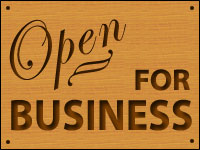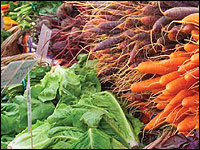
Whither lies the true “doorway” to the Web 2.0 world?
The search for this golden portal into the future Web has launched a mega-billion dollar corporate competitive scramble with no complete solution in sight — yet.
Portals come in three basic varieties, according to a study of portal business models by the University of Washington’s School of Business:
- Horizontal portals like Google, Yahoo, MSN and AOL provide gateway access to the Internet’s vast store of content and services along with a broad range of tools for locating information and Web sites, communicating with others and developing online communities of interest. They make money through advertising and transaction fees from multiple vertical solutions channels.
- Vertical portals like WebFlyer and WebMD provide deep content, a place to conduct business, learn and shop, communities and community-building tools. These portals are often composed of a variety of business models, all of which generate separate revenue streams, including advertising and referral fees (if transactions are not completed online). Service fees and transaction fees may be generated if transactions are completed online, and subscription fees may also be generated for unique content.
- Affinity portals like iVillage.com (women) and Realtor.com (realtors) provide deep content, commerce and community features like those found in vertical portals, but these offerings are targeted toward a specific market segment or even a specific gender. The revenue model is similar to vertical portals, with cost and asset models based on the business model adopted by the portal.
New York-based Internet specialist JupiterResearch predicts that 80 percent of U.S. households that are online will be using broadband by 2010. As a result, portals and content sites will be forced to compete for market share by experimenting with broadband-oriented technologies such as Flash-based home pages and customized RSS (really simple syndication) feeds.
Web 2.0
Web 2.0 refers primarily to two major paradigm shifts in the way people use the Web: thin client computing and user-generated content. The portal plays a pivotal role in both areas.
In thin client computing, data and applications are stored on Web servers, and a user has access from any computer via a Web browser, thus turning the Web into a gigantic application server — a penultimate manifestation of Web 2.0.
Google Apps is a collection of Google applications and utilities offered as a package, either free or paid for. In 2007, Google combined its e-mail, instant messaging, calendar, word processing, spreadsheet and Web authoring applications along with administration utilities into Standard and Premier Editions, which are free and paid, respectively.
By offering a paid, Web-based office suite of primary business applications with tech support, Google used the thin client computing concept to jump into the office software arena in direct competition with Microsoft Office suites.
The significant difference is that Google Apps is Web-based. Users can access sufficiently functional office applications (word processor, spreadsheet, etc.) online through the Google portal at a comparatively low price. With GoogleApps, Google has created a bona fide Web 2.0-like portal that has Microsoft very concerned for its earth-bound office application software business — another good reason for that US$44 billion bid for Yahoo.
User-generated content (UGC) involves posting digital video, blogging, podcasting, news, gossip, research, mobile phone photography and wikis on social networking sites like MySpace, Facebook and Flickr. UGC lets everyone have their say on anything and publish it to the world at large.
This is made possible through Web application services, a standardized way of integrating Web-based applications using the XML (Extensible Markup Language), SOAP, WSDL (Web Services Description Language) and UDDI (Universal Description Discovery and Integration) open standards over an Internet protocol backbone. XML is used to tag the data, SOAP is used to transfer the data, WSDL is used for describing the services available, and UDDI is used for listing what services are available.
Rich-Internet application techniques such as Ajax, Adobe Flash, Flex, Java, and Silverlight have the potential to improve the user-experience in browser-based applications. These technologies allow a Web page to request an update for some part of its content, and to alter that part in the browser, without needing to refresh the whole page at the same time.
Ajax (Asynchronous JavaScript and XML) is a group of interrelated Web development techniques used for creating interactive Web applications. A primary Ajax characteristic is the increased responsiveness and interactivity of Web pages achieved by exchanging small amounts of data with the server “behind the scenes” so that the entire Web page does not have to be reloaded each time the user performs an action. This increases the Web page’s interactivity, speed, functionality and usability.
Portlets (a.k.a. “gadgets,” “widgets,” “Web parts,” “mini-apps,” etc.) are specialized content areas that occupy small windows on portal pages — e.g., weather info, news flashes, stock tickers, etc. Java Specification Request (JSR) 168 standards enable portal developers, administrators and consumers to integrate standards-based portals and portlets across a variety of vendor solutions. As Web applications within a browser window, displayed in an effective layout, portlets are aggregated by the portal page.
User-friendly portals feature design elements that provide a usable and convenient interface to facilitate a user’s primary goal: finishing the task at hand. Good page design means clear and consistent navigational aids — page names, logos, banners, icons, background colors — as visual clues for users to move easily through the site’s menu structure, with content links and applications right on the home page or just a click away.
Modern portals embody all of the characteristics and capabilities of consumer Web 2.0 applications: dynamic usability (Ajax, drag-and-drop, in-place refresh), tagging, simpler user experiences and tools, participant-driven capabilities and experiences, says Mark Carges, executive vice president of portal vendor BEA Systems.
“For new Web 2.0 applications — wikis, blogs, collaborative search, mashups — portals are a logical aggregation point,” he told TechNewsWorld.
Ease of Use Paramount
As Web applications become more sophisticated, people can easily develop elaborate personal Web pages, create a blog, and upload their own opinions, audio and video. Users can augment the news by reporting hot stories, sometimes faster than and with details often overlooked or ignored by the professional news media.
“The dominant use of public portals is still aggregating news feeds,” observed Omar Al Zabir, CTO of Pageflakes and author of the book Building a Web 2.0 Portal with ASP.NET 3.5.
A Portal 2.0 candidate, Pageflakes is an Ajax-based start page and social networking site similar to Netvibes, MyYahoo, iGoogle and Microsoft Live. The site is organized into tabs, each tab containing user-selected modules called “Flakes.” Each Flake varies in content — information such as RSS/Atom feeds, calendar, to-do list, Web search, weather forecast, del.icio.us bookmarks, Flickr photos, social networking tools like Facebook, YouTube, Twitter, e-mail and user-created modules — designed for using the Web at school, work and at home.
“We have many varieties of verticals using Pageflakes as their portal,” Al Zabir told TechNewsWorld. “Education is the strongest among all. Teachers and students use Pageflakes to aggregate articles and news feeds, collect research materials on their portal pages. Social groups gather on Pageflakes and collaboratively work on their portals. Family pages show family members are bringing together family photos, calendars, to-do-lists and many interesting topics. RSS junkies use Pageflakes to aggregate hundreds of RSS feeds into organized tabs.”
UGC reflects the expansion of media production through new technologies that are accessible and affordable to the general public. In this New Media scenario, the traditional model of big media businesses generating content and consumers passively consuming is subsumed by a new paradigm in which the consumer has increasing control over the timing, channel and format by which content is created and absorbed.
The basic problem with this setup is that it requires time and energy to pull it off properly. Web 2.0 is really about building applications that make everyday tasks easier, according to Publishing 2.0 blogger Scott Karp. His examples of successful portals include Google (search), eBay (sell/buy), Amazon reviews/recommendations (shop) and Flickr (organize/share photos). Karp makes the case that the average person doesn’t have much time or interest in doing a lot of voting, tagging, saving, commenting and creating media, and has patience for only a finite amount of choice. Web 2.0 media applications, according to Karp, are really just for bloggers and other people with the drive to create their own media.
“For most of us, media consumption consists of reading or viewing and then moving on to something else,” he said.
Karp highlights “ease of use” as the key factor in any successful Web 2.0 portal. He gives Flickr and MySpace props as shining examples of doing things right.
“Flickr makes the task at hand (organizing/sharing pictures) easier,” he contended. “What problem does MySpace solve? It’s not about media consumption, and it’s not even about content creation. It’s about what young people in particular want to do most: socialize. MySpace makes it easier to hang out and be seen. It makes it easy to create your own space — something that is difficult for teenagers, indie bands, etc.”
Facebook also has its advocates. David Sacks, the founder and CEO of new startup Geni (and previously PayPal COO) said that Facebook has a new answer to the portal question — the “social graph,” or a person’s network of relationships, will push information to that individual.
“The potential for Facebook to layer on any feature whose value increases with the participation of friends is an incredibly broad canvas for a portal,” Sacks blogged on TechCrunch. “Moreover, as each new application gains acceptance, it enriches the overall value of the network and makes it incrementally more likely that the next application will be tried. Much of what we know as ‘Web 2.0’ will eventually be rebuilt on top of Facebook.”
The Web’s growing complexity has made portals essential to Internet users, Web20Portals.com’s Jacques Beaudoin told TechNewsWorld.
“Due to the growing complexity of the Web, portals have become essential to the Internet users in this new Web 2.0 world. By providing a pathway to other content, portals facilitate the access to information and make the users experience more enjoyable and rewarding. This is why portals are now experiencing serious growth and in my opinion will keep on growing in the future as their usage will become more and more indispensable.”





















































Hi Ned
Great detail article on Web 2.0 Portals World. Thank you for my blog mention in your research.
Best Regards, Jacques Beaudoin
Admin
http://www.Web20Portals.com